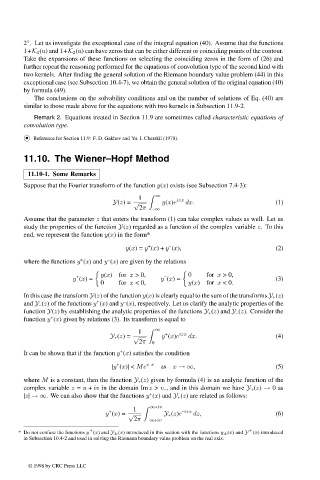Page 579 - Handbook Of Integral Equations
P. 579
2 . Let us investigate the exceptional case of the integral equation (40). Assume that the functions
◦
1+K 1 (u) and 1+K 2 (u) can have zeros that can be either different or coinciding points of the contour.
Take the expansions of these functions on selecting the coinciding zeros in the form of (26) and
further repeat the reasoning performed for the equations of convolution type of the second kind with
two kernels. After finding the general solution of the Riemann boundary value problem (44) in this
exceptional case (see Subsection 10.4-7), we obtain the general solution of the original equation (40)
by formula (49).
The conclusions on the solvability conditions and on the number of solutions of Eq. (40) are
similar to those made above for the equations with two kernels in Subsection 11.9-2.
Remark 2. Equations treated in Section 11.9 are sometimes called characteristic equations of
convolution type.
•
Reference for Section 11.9: F. D. Gakhov and Yu. I. Cherskii (1978).
11.10. The Wiener–Hopf Method
11.10-1. Some Remarks
Suppose that the Fourier transform of the function y(x) exists (see Subsection 7.4-3):
1 ∞ izx
Y(z)= √ y(x)e dx. (1)
2π –∞
Assume that the parameter z that enters the transform (1) can take complex values as well. Let us
study the properties of the function Y(z) regarded as a function of the complex variable z. To this
end, we represent the function y(x) in the form*
+
–
y(x)= y (x)+ y (x), (2)
–
+
where the functions y (x) and y (x) are given by the relations
y(x) for x >0, – 0 for x >0,
+
y (x)= y (x)= (3)
0 for x <0, y(x) for x <0.
In this case the transform Y(z) of the function y(x) is clearly equal to the sum of the transforms Y + (z)
+
–
and Y – (z) of the functions y (x) and y (x), respectively. Let us clarify the analytic properties of the
function Y(z) by establishing the analytic properties of the functions Y + (z) and Y – (z). Consider the
+
function y (x) given by relations (3). Its transform is equal to
1 ∞ + izx
Y + (z)= √ y (x)e dx. (4)
2π 0
+
It can be shown that if the function y (x) satisfies the condition
+
|y (x)| < Me v – x as x →∞, (5)
where M is a constant, then the function Y + (z) given by formula (4) is an analytic function of the
complex variable z = u + iv in the domain Im z > v – , and in this domain we have Y + (z) → 0as
+
|z| →∞. We can also show that the functions y (x) and Y + (z) are related as follows:
∞+iv
1
+ –izx
y (x)= √ Y + (z)e dz, (6)
2π –∞+iv
* Do not confuse the functions y (x) and Y ±(x) introduced in this section with the functions y ±(x) and Y (x) introduced
±
±
in Subsection 10.4-2 and used in solving the Riemann boundary value problem on the real axis.
© 1998 by CRC Press LLC
© 1998 by CRC Press LLC
Page 562

